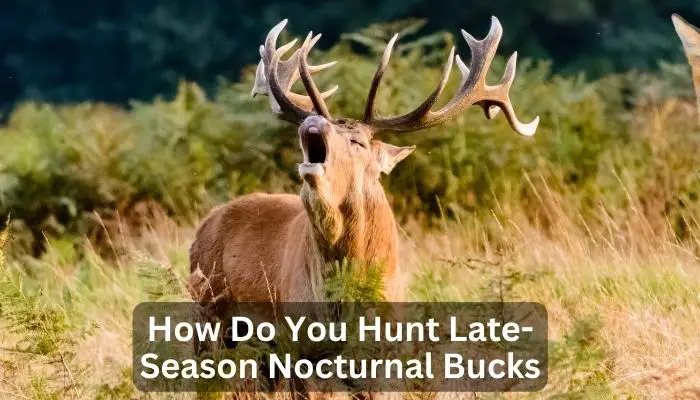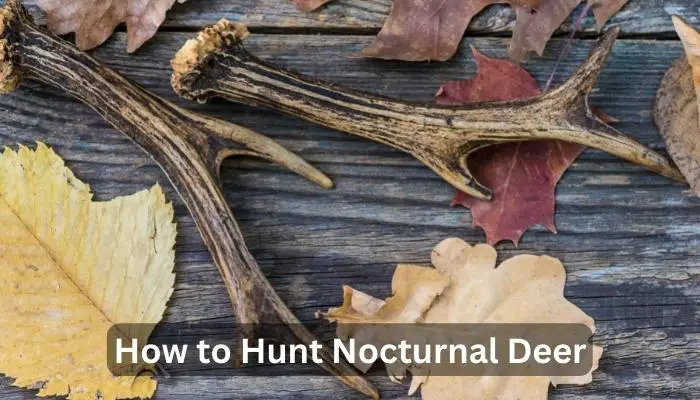The rut is over, and the bucks have dispersed back into their home ranges. Now it’s time to hunt for those big, late-season nocturnal bucks. But How to Hunt Nocturnal Whitetail Bucks?
The rut is arguably the best time to hunt whitetail bucks. This is when they are most active and, thus, most vulnerable. But what if you can’t hunt during the day?
Hunting nocturnal bucks can be challenging, but it’s certainly not impossible. Here are a few tips to help you successfully hunt these elusive creatures of the night. Let’s explore it.
Contents
How to Hunt Nocturnal Whitetail Bucks
- Look for rubs: Bucks make marks on trees with their antler. They do this to leave their scent and mark their territory. If you find a rub, it’s a good sign of a buck nearby.
- Look for scrapes: Scrapes are another way that bucks mark their territory. They will scrape the ground with their hooves to leave their scent. If you find a scrape, it’s a good sign that there is a buck nearby.
- Look for feeding areas: Bucks often feed in areas with plenty of food. A buck has likely been feeding there if you find a place where the vegetation has been recently disturbed.
- Set up a hunting blind: Once you’ve found an area where you think bucks are likely to be, the next step is to set up a hunting blind. This will allow you to wait quietly and undetected while the bucks roam near your position.
How Do You Hunt Late-Season Nocturnal Bucks

There are a few things that you need to do to be successful at hunting late-season nocturnal bucks. First, you need to find out where they are traveling and feeding. Second, you need to set up your stand or blind in a strategic location so that you can intercept them on their travels.
And third, you must be patient and wait for the right opportunity to take your shot. To find out where the bucks are traveling and feeding, look for fresh tracks and droppings in areas such as field edges, thickets, or along rub lines. You can also use trail cameras to get an idea of where the deer are moving about during the day and night.
Once you have a general idea of where they are spending their time, set up your stand or blind nearby so that you can intercept them on their travels. Be patient when hunting late-season nocturnal bucks, and wait for the right opportunity to take your shot.
These deer are weary of being pursued by hunters all season long and will be much more challenging to take down than early-season deer.
How to Hunt Nocturnal Deer

Whether you’re a seasoned hunter or new to the sport, deer hunting can be a challenging and rewarding experience. And while most deer are active during the day, some species are more active at night—making them a bit more difficult to hunt. But with the proper preparation and knowledge, you can successfully hunt nocturnal deer.
Here are a few tips on hunting nocturnal deer: 1. Know your prey: As with any hunting expedition, it’s essential to understand your game. Learn as much as possible about the habits and behaviors of the specific type of deer you’re hoping to bag.
This information will help you choose the best time and place to set up your hunt. 2. Choose the right equipment: In addition to your usual hunting gear, you may need additional items when hunting nocturnal deer. A good pair of night vision goggles or binoculars will come in handy for spotting deer in low-light conditions.
You may also want to invest in a quality flashlight or headlamp so you can see where you’re walking after dark. 3. Set up camp near water: One way to attract nocturnal deer is to set up camp near water sources—they often come out at night to drink.
Frequently Asked Question
How Do You Get a Nocturnal Deer to Come Out During the Day?
Nocturnal deer are most active at dawn and dusk, so you may have more luck if you can position yourself near their bedding areas early in the morning or late in the evening.
If you see a nocturnal deer during the day, don’t approach it too quickly or make too much noise, as this could startle it and cause it to bolt back into hiding.
How Do You Get a Big Buck to Come Out in Daylight?
You can do a few things to increase your chances of getting a big buck to come out in daylight.
- First, try hunting during the early morning or evening hours when the deer are most active.
- Next, use a decoy or attractant to bring the deer into your area.
Finally, ensure you’re well camouflaged to not startle the deer and scare them away. Following these tips will improve your chances of success when hunting for big bucks in daylight hours.
How Far Do Mature Bucks Travel at Night?
Mature bucks travel an average of 1.5 miles per night. However, they have been known to travel up to 5 miles per night in search of food or mates.
Conclusion
Hopefully, this blog post described how to Hunt Nocturnal Whitetail Bucks. Also, some offer tips on staying safe and comfortable while hunting at night. So, the last piece of advice for you that make sure that you’re prepared mentally and physically for a long night of waiting before taking your shot.

